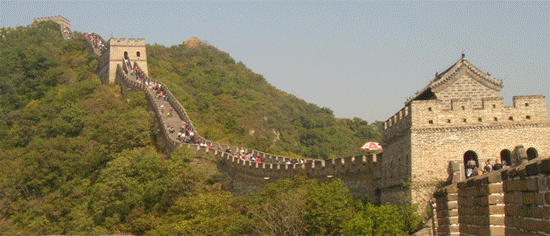By the start of the 15th century, China had thrown off its
earlier Mongol ruling regime and a new dynasty had commenced, the Ming dynasty,
which would rule until 1644. A key concept that undergirded authority in China
was the idea of the “mandate of heaven,” a concept that went back to the 4th
century B.C. and was introduced by Confucian scholars. The heavenly mandate
meant that when a ruler or a dynasty ruled in accordance with the laws of
harmony in nature, its virtue would produce prosperity, well-being, and a
government that was good for the people at large. By contrast, rulers whose
misrule violated the mandate of heaven would bring down social disorder and
natural disasters: floods, famines, plagues.
After the disruptions that had passed under previous Mongol
rule, the Ming dynasty prized stability and order—deeply Confucian values. The
name of the emperor, Yongle, meant “perpetual happiness.” At this time, Ming
China had the most wealth and population of any economy in the world. At this
time, China presented a dramatic contrast with Europe—an advanced civilization
compared to a society that remained relatively primitive.
The Ming dynasty was not isolated or intellectually
incurious, and its earliest rulers were adventurous. Emperor Yongle fought
against the Mongols, invaded Vietnam, and ordered his great admiral, Zheng He,
to launch a series of voyages across the Indian Ocean. At the orders of his
emperor, Zheng He sailed on seven voyages throughout Asia. The first of these
took place in 1405 and the last in 1433. The fleets sailed to Malacca, Java,
Sumatra in Indonesia, Thailand, Sri Lanka, Siam, India, the Persian Gulf, the Red
Sea, Somalia, Zanzibar, and perhaps, Kenya
.
These fleets must have been imposing to see! Along with many
smaller boats were the great treasure ships, 400 feet long with up to nine
masts, watertight bulkheads, multiple cabins and decks, and huge crews.
Europeans at this point had nothing that could compare. The voyages had many
different purposes, but common to all was the projection of an image of power
throughout the region to impress the claims to China’s centrality and the
emperor’s authority.
In 1433, these diplomatic voyages were stopped. What if the
fleets had continued and had ranged even further? What if they had rounded the
southern tip of Africa and continued westward to discover the American
continents? Or what if they had headed beyond Java to come at new worlds from
the east? A tantalising prospect in the history of World discovery!
Why were the voyages discontinued? First, Zheng He himself
died in 1433. A tomb exists today in his hometown of Nanjing, but it is empty
and, for many years, was all but forgotten. Economic pressures may also have
played a role as internal improvements made domestic trade more profitable than
speculative overseas trade. The real point of the voyages was to awe with what
we today would call “soft power”: the glory, impressiveness, and riches of
Chinese culture, which the imperial elite saw as central to the world as a
whole. The expeditions were about confirming something that was already known:
the universal authority of the Chinese emperor and China’s civilization. So, With
the imperial Chinese authority so dramatically vindicated the mission of the
voyages was accomplished.
From: The Great Courses - Turning Points in History



No comments:
Post a Comment